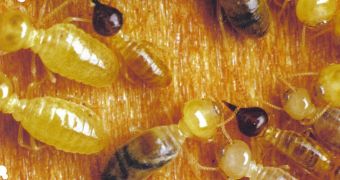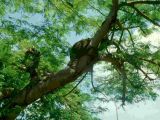In just a few months, termites can turn a woodhouse into dust. But it is exactly this ability that can deliver us greener biofuel. Their abdomens harbor a treasure of microbes that could deliver enzymes for turning wood or waste biomass into biofuels and a new DNA analysis published in the journal Nature represents a step forward.
"Termites can digest a frightening amount of wood in a very short time, as anyone who has had termites in their house is painfully aware. Instead of using harsh chemicals or excess heat to do so, termites employ an array of specialized microbes in their hindguts to break down the cell walls of plant material and catalyze the digestion process. Our task now is to discover the metabolic pathways generated by these structures to figure out how nature digests plant materials. We can then synthesize the novel enzymes discovered through this project to accelerate the delivery of the next generation of cellulosic biofuels." said Dr. Raymond L. Orbach, Under Secretary for Science, U.S. Department of Energy, whose program supports U.S. Department of Energy Joint Genome Institute (DOE JGI).
Like sheep and cows, termites have a series of stomachs, each comprising its distinct community of microbes, involved in particular stages of converting the wood polymers (cellulose, hemicellulose and lignin, which form 99 % of the dry wood) to sugars. The termites digest the sugars, while humans can ferment them into fuels like ethanol.
The researchers investigated the gut bugs from a forest termite of Costa Rica, Nasutitermes, which forms tumor-like nests clinging on trees. The bacteria were isolated from the guts of the larger "workers". The complex DNA analysis revealed the existence of 12 different bacteria groups.
"Our analysis revealed that the hindgut is dominated by two major bacterial lineages, treponemes and fibrobacters," said co-author Phil Hugenholtz, chief of the DOE JGI's Microbial Ecology Program.
"Treponemes have long been recognized in the termite gut due to their distinctive cork-screw shape, but fibrobacters were an exciting new find, because they have relatives in the cow rumen known to degrade cellulose. We could directly link the termite fibrobacters and treponemes to enzymes capable of breaking down wood. However, fibrobacters are specialists in this regard and don't appear to participate in sugar fermentation, leaving that to the treponemes. This project has really given me a new appreciation for the lowly termite, a mobile miniature bioreactor."
Over 500 genes connected to the enzymatic breakdown of cellulose and hemicellulose were detected.
"Termites can efficiently convert milligrams of lignocellulose into fermentable sugars in their tiny bioreactor hindguts. Scaling up this process so that biomass factories can produce biofuels more efficiently and economically is another story. To get there, we must define the set of genes with key functional attributes for the breakdown of cellulose, and this study represents an essential step along that path." said Eddy Rubin, JGI Director.
Researchers are also searching for biofuel producing bacterium genes in the forestomach of the Tammar wallaby, the Asian longhorned beetle gut and other species.

 14 DAY TRIAL //
14 DAY TRIAL // 
